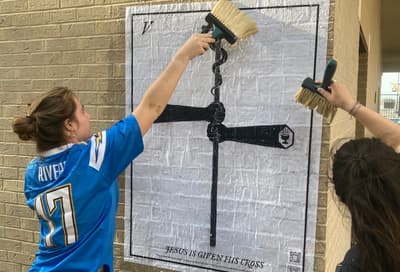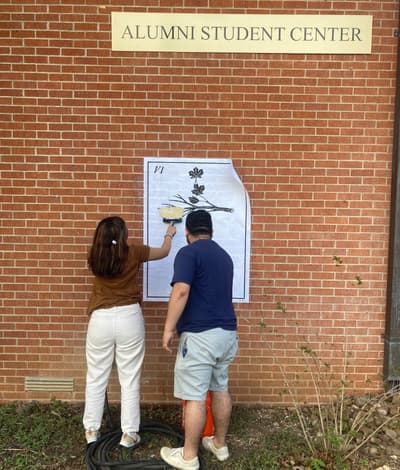As part of a bigger initiative made possible by the Bogisch Student Faith Fund, the Theology Department is exploring how to move the spiritual formation of students out of the classroom and into their lived experience. Assistant Professor Amanda Kaminski and Associate Professor Carl Hughes are leading efforts that acknowledge how students’ spirituality is changing and no longer confined to formal spaces like churches or Bible study, even though those spaces are still occupied.
One of the ways they are doing this is by telling the story of the Stations Of The Cross through the unique concept of street art with Austin-based artist Scott Erickson's Stations In The Street—a downloadable show meant to serve all kinds of communities during the season of Lent— creates work in nontraditional media (tattoos/graphic design) for use in digital and nontraditional spaces. A total of 11 stations can be found throughout campus, from Langner Hall and Chapel to Bulldog Gymnasium and Hein Dining Hall.
View A Map Of Station Locations
The Stations of the Cross began as a remembrance that pilgrims had when they were retracing Jesus’ finals steps in Jerusalem up to the hill where He was crucified. Wanting to share that practice and experience with people who couldn’t make the trip to Jerusalem, these same pilgrims created local stations of meditation that became in itself a tradition. This tradition is still found on the inside of many churches today.

Another reason Kaminski says they chose Erickson’s show was that it’s reminiscent of protest art which typically features visual representation intended to disrupt the public's normal experience.
“This type of art happens in liminal spaces where art isn't supposed to be,” she said. “Much like graffiti, it’s a type of civil disobedience and it makes me stop and look. We wanted to see how we could take the most sacred holiday in the Christian faith—Holy Week and Easter—and bring it into a space our students are familiar with.
“Scott is developing religious visual productions in public spaces showing the last hours of Christ's life on earth, his walk toward crucifixion, and then His resurrection. Those visuals are often only depicted in churches and very formal spaces that don’t necessarily connect with our students’ lived experience. Station in The Street takes the ancient tradition of the holy pilgrimage and brings it to us. We are then connecting spirituality and protest art and asking our students to have deeper conversations about their own faith.”
Kaminski says she hopes the artwork helps students encounter Jesus’ story and experience in his final hours as it may relate to their own experiences of mocking, shame, or defeat as it pertains to their own life. The students are telling this story and their own reflections on their Instagram @tluthinkingtheo. The account aims to share curated theological content and provide an atmosphere for relationality, religious questioning, and compelling storytelling. The group encourages everyone to share their thoughts about the Stations Of The Cross artwork and there are even QR codes on every piece linking to guided mediations.

“We asked students what initiatives they wanted to see that would help them cultivate their own faith and how they might develop their own leadership for personal growth and a more just world,” she said. “After talking with them we found two things: 1) Our students are very passionate about social justice and causes; 2) they are social media and phone obsessed. This led me to explore protest art and Scott’s Stations In The Street is inviting people to look up from their phones. We know students really connect on social media we are embracing that.”
These connections in virtual spaces are very real, Kaminski says, and it’s where students are building their identities. “We recognize that social media is a space to build community and encouraging spiritual questioning, deeper relational skills, spirituality, and important moments in the world religious calendar. “There are big, sacred stories and we want to teach them to our students in a virtual space where they can connect with probing techniques and deep spirituality and have them in lived spaces. Whether you're a student, a staff member, or someone visiting our campus, we want you to look up, encounter the artwork, and be part of a narrative. From our belief, this is the story that changed the world and we want to make it available to anyone.”
